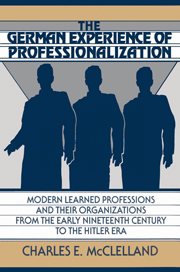 The German Experience of Professionalization
The German Experience of Professionalization Book contents
- Frontmatter
- Contents
- Acknowledgments
- Abbreviations
- Part I The problem of professions in Germany
- Part II The transition to modern professions in the early nineteenth century
- Part III Unified professions in a unified Germany?
- Part IV Breakthroughs and breakdowns: The professions enter the era of cartels and unions
- Part V The Weimar era
- 10 The “free” professions under Weimar
- 11 Professions based on law and pedagogy in the Weimar era
- Part VI The fate of professions under and after fascism
- A word about sources
- Index
11 - Professions based on law and pedagogy in the Weimar era
Published online by Cambridge University Press: 06 July 2010
- Frontmatter
- Contents
- Acknowledgments
- Abbreviations
- Part I The problem of professions in Germany
- Part II The transition to modern professions in the early nineteenth century
- Part III Unified professions in a unified Germany?
- Part IV Breakthroughs and breakdowns: The professions enter the era of cartels and unions
- Part V The Weimar era
- 10 The “free” professions under Weimar
- 11 Professions based on law and pedagogy in the Weimar era
- Part VI The fate of professions under and after fascism
- A word about sources
- Index
Summary
LAW-BASED PROFESSIONS
As we saw in Chapter 9, the market situation of attorneys by World War I was becoming sufficiently worrisome that some lawyers, although not the DAV, had begun to call for restrictions on admission to the profession. Having almost doubled (from 6,600 to 13,000) between 1899 and 1915, the number of attorneys in Germany remained relatively stable (under 13,000) until 1925, when it began to grow. By 1928 it had reached 15,500, and law enrollments were also rising, producing a pool of attorneys approaching 19,000 by 1935. Despite some population growth, this meant an increase from 19 attorneys per 100,000 in 1919 to 24 per 100,000 in 1928. At the same time, the field of activity for lawyers was being reduced by various measures, for example, by raising the income ceilings for those eligible to use the (lawyer-free) Gewerbe- und Kaufmanngerichte, special courts set up to settle disputes between employers and their employees. Similarly, new or reorganized courts such as the national Financial Court, Economic Court, and Administrative Court limited or excluded representation of parties by lawyers. The tendency in Weimar was away from the older principle of Anwaltszwang. The bureaucrats claimed such streamlined justice was cheaper and faster for the people; attorneys claimed it weakened the rights of the parties.
One compulsory aspect of legal practice that remained from the old Reich was the fee schedules.
- Type
- Chapter
- Information
- The German Experience of ProfessionalizationModern Learned Professions and their Organizations from the Early Nineteenth Century to the Hitler Era, pp. 193 - 214Publisher: Cambridge University PressPrint publication year: 1991
